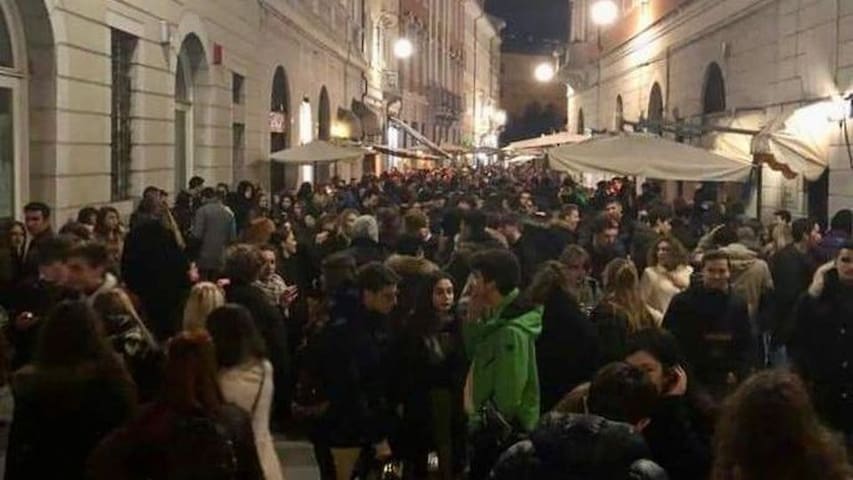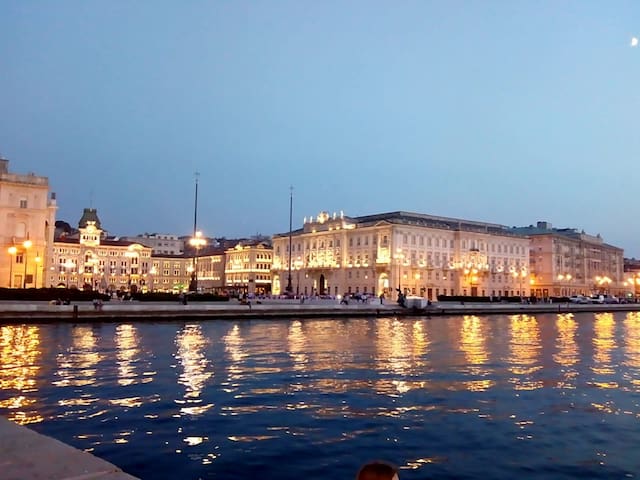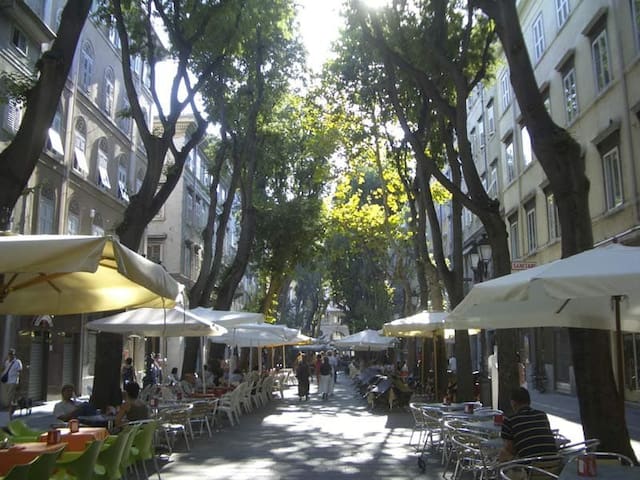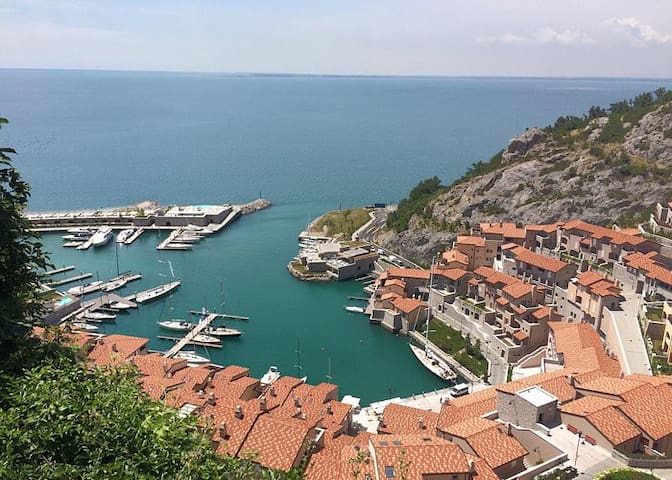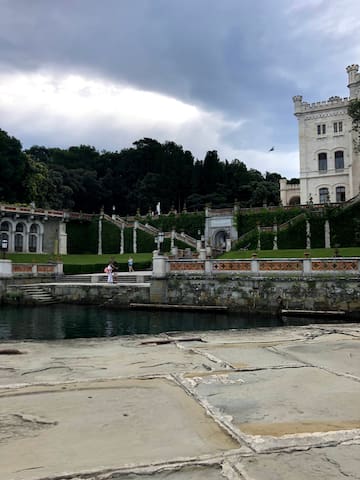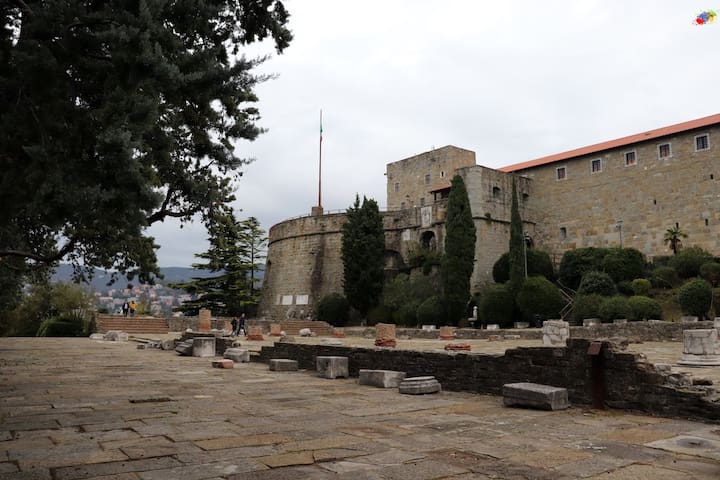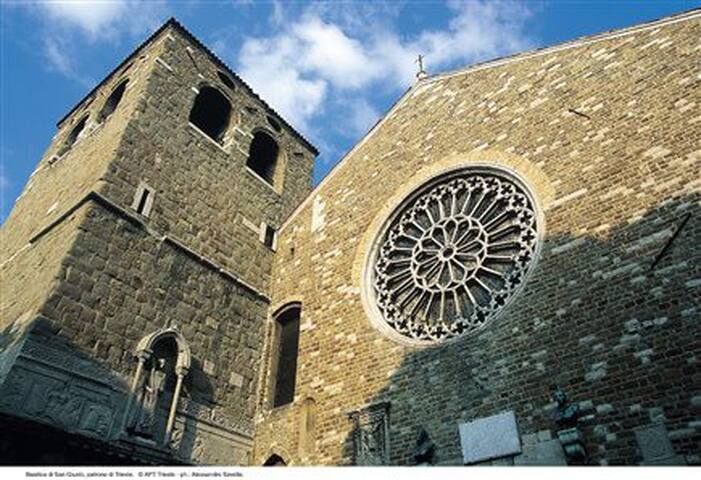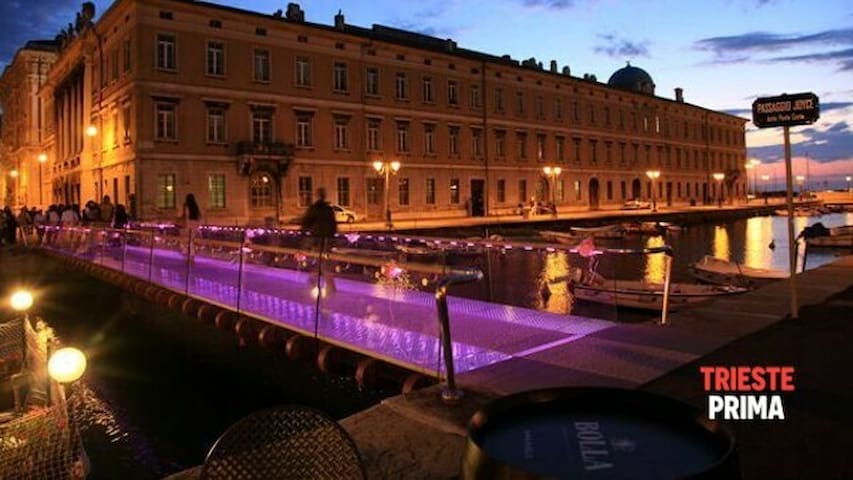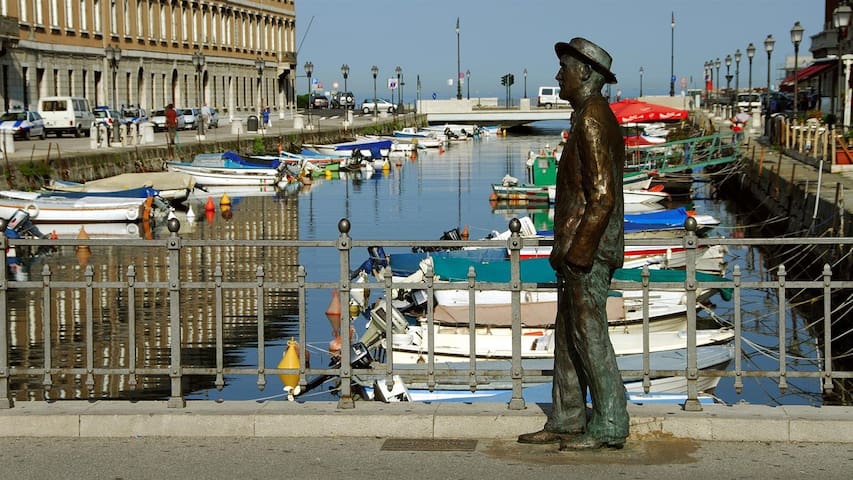Le Guide ai Quartieri
The Jewish neighbourhood is located between Piazza della Borsa and the Roman Theater, near Piazza Unità d'Italia and is bordered between contrada Malcanton, contrada Riborgo and contrada delle Beccherie.
Via delle Ombrelle, 6
6 Via delle OmbrelleThe Jewish neighbourhood is located between Piazza della Borsa and the Roman Theater, near Piazza Unità d'Italia and is bordered between contrada Malcanton, contrada Riborgo and contrada delle Beccherie.
Trieste by night
Popular Trieste's street well known for night lifestyle (and not only), charming & attractive experience for a pleasent evening!
33 recommandé par les habitants
Via Torino
Via TorinoTrieste by night
Popular Trieste's street well known for night lifestyle (and not only), charming & attractive experience for a pleasent evening!
The largest square facing the sea in Europe.
When you arrive in Trieste by sea, the city seems to welcome you with open arms.
The creation of the square was the final show of power, strength and solidity of a great empire that was drawing to an end. It brings to mind the final act of a theatre performance, with a line-up of all of the leading players that made the city great: the Art Nouveau government building, the Assicurazioni Generali building and the Lloyd Triestino building, cornerstones of the commercial hub, and City Hall, which was the last to be built.
In the past, the old marina was located here - the blue lights on the pavement of the square indicate the former water's edge. In addition, the square was closed off from the sea by a building that was located along the shore.
Over its history, it has often been the setting for events that shaped the destiny of the inhabitants of the city and beyond.
Examples of just a few such events from the twentieth century follow. On 2 July 1914, the boat decorated for mourning that transported the remains of Archduke Franz Ferdinand and his wife Sophie landed at the quayside of this square, marking the end of a world.
On 3 November 1918, crowds of residents joyously awaited the beginning of a new chapter in the city's history, with the arrival of the destroyer Audace and the birth of a new Italy. In this same square, on 18 September 1938, Mussolini's terrible words announced the enactment of the Racial Laws from a stage built for the occasion. The speech was transmitted by radio to squares throughout Italy and beyond. In memory of this sad day, the city erected a bronze commemorative plaque on 18 September 2013. Finally, on 26 October 1954, crowds cheered the arrival of Italian troops once again.
Merchants, sailors, intellectuals, tourists and crowned heads of state have landed in this beautiful square - it is not by chance that the residents affectionately call it the "city's front parlour". It was and is a square for receiving guests!
Today, as in the past, people meet in the square to drink a coffee at the bar on a Sunday morning or enjoy an aperitif while watching the sunset. It is also here that children take their first steps, ride bicycles and chase after each other.
158 recommandé par les habitants
Place de l'Unité d'Italie
Piazza Unità d'ItaliaThe largest square facing the sea in Europe.
When you arrive in Trieste by sea, the city seems to welcome you with open arms.
The creation of the square was the final show of power, strength and solidity of a great empire that was drawing to an end. It brings to mind the final act of a theatre performance, with a line-up of all of the leading players that made the city great: the Art Nouveau government building, the Assicurazioni Generali building and the Lloyd Triestino building, cornerstones of the commercial hub, and City Hall, which was the last to be built.
In the past, the old marina was located here - the blue lights on the pavement of the square indicate the former water's edge. In addition, the square was closed off from the sea by a building that was located along the shore.
Over its history, it has often been the setting for events that shaped the destiny of the inhabitants of the city and beyond.
Examples of just a few such events from the twentieth century follow. On 2 July 1914, the boat decorated for mourning that transported the remains of Archduke Franz Ferdinand and his wife Sophie landed at the quayside of this square, marking the end of a world.
On 3 November 1918, crowds of residents joyously awaited the beginning of a new chapter in the city's history, with the arrival of the destroyer Audace and the birth of a new Italy. In this same square, on 18 September 1938, Mussolini's terrible words announced the enactment of the Racial Laws from a stage built for the occasion. The speech was transmitted by radio to squares throughout Italy and beyond. In memory of this sad day, the city erected a bronze commemorative plaque on 18 September 2013. Finally, on 26 October 1954, crowds cheered the arrival of Italian troops once again.
Merchants, sailors, intellectuals, tourists and crowned heads of state have landed in this beautiful square - it is not by chance that the residents affectionately call it the "city's front parlour". It was and is a square for receiving guests!
Today, as in the past, people meet in the square to drink a coffee at the bar on a Sunday morning or enjoy an aperitif while watching the sunset. It is also here that children take their first steps, ride bicycles and chase after each other.
Piazza del Ponterosso
Piazza del PonterossoCorso Italia
Corso ItaliaShopping
Viale XX Settembre
Viale Venti SettembreInformazioni sulla città/località
Duino
Old fashioned Medieval Castle of Duino, 1389
Sistiana, in the municipality of Duino-Aurisina, is a quiet location that provides a spectacular view over the Adriatic sea. Surrounded by rich vegetation, it features a varied Karst landscape where maquis, rocky and calcareous masses and beautiful little harbours are perfectly combined.
Sistiana can boast a peaceful and protected bay, a renowned holiday resort in the Austro-Hungarian period. Today, you will find a tourist port, bathing establishments and well-tended and clean beaches. You will also find many restaurants, where you can taste the excellent local seafood.
Those who love to walk in nature can follow the about two kilometres of the charming Rilke Path - between Sistiana and Duino - dedicated to the poet Rainer Maria Rilke from Prague, who in 1911-1912 stayed at the castle of Duino, as a guest of the Thurn und Taxis princes, and who in his "Elegie Duinesi" recalls the magnificence of the Karst coast.
Not only sea, in Sistiana, but also history, nature and legends…
Near Sistiana, still in the municipality of Duino-Aurisina, you can visit the resurgences of the Timavo river and in the surroundings stands the Church of San Giovanni in Tuba. According to the legend, Jason arrived at these resurgences with his Argonauts, escaping from the Black Sea with the Golden Fleece, managing to save himself going up the Timavo. It is also said that, along the sources of the river, in the surroundings of the near Mount Hermada, there would have been a sacred forest, the place for sacrifices to Diomedes, after his passage at the end of the war of Troy.
7 recommandé par les habitants
Sistiana
Sistiana, in the municipality of Duino-Aurisina, is a quiet location that provides a spectacular view over the Adriatic sea. Surrounded by rich vegetation, it features a varied Karst landscape where maquis, rocky and calcareous masses and beautiful little harbours are perfectly combined.
Sistiana can boast a peaceful and protected bay, a renowned holiday resort in the Austro-Hungarian period. Today, you will find a tourist port, bathing establishments and well-tended and clean beaches. You will also find many restaurants, where you can taste the excellent local seafood.
Those who love to walk in nature can follow the about two kilometres of the charming Rilke Path - between Sistiana and Duino - dedicated to the poet Rainer Maria Rilke from Prague, who in 1911-1912 stayed at the castle of Duino, as a guest of the Thurn und Taxis princes, and who in his "Elegie Duinesi" recalls the magnificence of the Karst coast.
Not only sea, in Sistiana, but also history, nature and legends…
Near Sistiana, still in the municipality of Duino-Aurisina, you can visit the resurgences of the Timavo river and in the surroundings stands the Church of San Giovanni in Tuba. According to the legend, Jason arrived at these resurgences with his Argonauts, escaping from the Black Sea with the Golden Fleece, managing to save himself going up the Timavo. It is also said that, along the sources of the river, in the surroundings of the near Mount Hermada, there would have been a sacred forest, the place for sacrifices to Diomedes, after his passage at the end of the war of Troy.
Visite turistiche
The Park of Miramare is open every day except December 25th and January 1st
Every first Sunday of the month
the admission to the Castle will be free.
The Castle can be visited from Monday to Sunday from 9.00 am to 7.00 pm
(last entry at 6.30 pm).
224 recommandé par les habitants
Château de Miramare
Viale MiramareThe Park of Miramare is open every day except December 25th and January 1st
Every first Sunday of the month
the admission to the Castle will be free.
The Castle can be visited from Monday to Sunday from 9.00 am to 7.00 pm
(last entry at 6.30 pm).
One of the most representative symbols of the city, the Castle of San Giusto stands on the hill overlooking the city, its gulf and its hinterland.
Summer(April 1st - September 30th)
every day 10 am-7pm
Winter (October 1st-March 31st)
Tuesday-Sunday 10-17 and museum
Full € 5.00
Reduced € 3.00
33 recommandé par les habitants
Al Castello di San Giusto
35 Via S. MicheleOne of the most representative symbols of the city, the Castle of San Giusto stands on the hill overlooking the city, its gulf and its hinterland.
Summer(April 1st - September 30th)
every day 10 am-7pm
Winter (October 1st-March 31st)
Tuesday-Sunday 10-17 and museum
Full € 5.00
Reduced € 3.00
The Grotta Gigante is a karst cave, explored in 1840 and opened to tourism by the Touristi Triestini Club as early as 1908.
Curiosity: Inside the cave there could be the church of San Pietro del Vaticano
JULY AND AUGUST OPEN EVERYDAY
SEPTEMBER 2022 OPEN FROM TUESDAY TO SUNDAY
CLOSING DAY MONDAY
BUS number 42 departing from Piazza Oberdan (terminus) or from Viale Miramare (Central Station side exit, PAM supermarket side stop).
Average travel time 35 min.
94 recommandé par les habitants
Grotte Géante
42 / A Borgo Grotta GiganteThe Grotta Gigante is a karst cave, explored in 1840 and opened to tourism by the Touristi Triestini Club as early as 1908.
Curiosity: Inside the cave there could be the church of San Pietro del Vaticano
JULY AND AUGUST OPEN EVERYDAY
SEPTEMBER 2022 OPEN FROM TUESDAY TO SUNDAY
CLOSING DAY MONDAY
BUS number 42 departing from Piazza Oberdan (terminus) or from Viale Miramare (Central Station side exit, PAM supermarket side stop).
Average travel time 35 min.
It is open from March 31st to November 4th, Friday to Sunday according to the timetable. In July and August the opening is anticipated to Wednesday.
Admission is free.
April, May, June and September:
Fridays from 3pm to 7pm;
Saturdays and Sundays from 10 a.m. to 1 p.m. and 3 p.m. to 7 p.m.
July and August
Wednesday to Sunday from 10 a.m. to 1 p.m. and 4 p.m. to 7 p.m.
October (except 7th, 8th and 9th):
Fridays from 3 p.m. to 6 p.m;
Saturday and Sunday from 10 a.m. to 1 p.m. and 3 p.m. to 6 p.m; from 05 to 09 continuous hours from 9.30 am to 5.30 pm (Barcolana)
November
from the 1st to the 4th: non-stop 9.30 am - 4.30 pm
Special openings
18 and 25 April, 2 June, 15 August, non-stop from 10.00 to 19.00
36 recommandé par les habitants
Phare de la Victoire
141 Str. del FriuliIt is open from March 31st to November 4th, Friday to Sunday according to the timetable. In July and August the opening is anticipated to Wednesday.
Admission is free.
April, May, June and September:
Fridays from 3pm to 7pm;
Saturdays and Sundays from 10 a.m. to 1 p.m. and 3 p.m. to 7 p.m.
July and August
Wednesday to Sunday from 10 a.m. to 1 p.m. and 4 p.m. to 7 p.m.
October (except 7th, 8th and 9th):
Fridays from 3 p.m. to 6 p.m;
Saturday and Sunday from 10 a.m. to 1 p.m. and 3 p.m. to 6 p.m; from 05 to 09 continuous hours from 9.30 am to 5.30 pm (Barcolana)
November
from the 1st to the 4th: non-stop 9.30 am - 4.30 pm
Special openings
18 and 25 April, 2 June, 15 August, non-stop from 10.00 to 19.00
Scala Dei Giganti
7 Galleria Scipione De SandrinelliFor an exceptional view of the city from above
Place de la Bourse
snc Piazza della BorsaAusonia Beach Club
1 Riva TraianaTo have fun
Beach Barcola
Lungomare Benedetto Croceseaside
The pier was built between 1743 and 1751 on the wreck of the San Carlo, a ship that sank in the harbour. Originally 95 metres long and connected to land by a small wooden bridge, the pier has been gradually lengthened and now measures 246 metres.
In 1922 the pier was renamed Molo Audace in honour of the destroyer Audace, the first ship of the Italian Navy to arrive in Trieste, on November 3, 1918.
A point of interest: the anchor of the destroyer Audace is on display at the base of the Vittoria lighthouse.
Coming to Trieste and not spending time along this walkway across the sea would be a crime! Don't miss this fascinating experience!
45 recommandé par les habitants
Jetée Audace
The pier was built between 1743 and 1751 on the wreck of the San Carlo, a ship that sank in the harbour. Originally 95 metres long and connected to land by a small wooden bridge, the pier has been gradually lengthened and now measures 246 metres.
In 1922 the pier was renamed Molo Audace in honour of the destroyer Audace, the first ship of the Italian Navy to arrive in Trieste, on November 3, 1918.
A point of interest: the anchor of the destroyer Audace is on display at the base of the Vittoria lighthouse.
Coming to Trieste and not spending time along this walkway across the sea would be a crime! Don't miss this fascinating experience!
The Cathedral of San Giusto stands on the hill of the same name, in the heart of the ancient Roman city of Tergeste.
Initially, towards the middle of the fifth century, an Early Christian basilica featuring a nave and two aisles, a presbytery with an apse, and mosaic flooring, was built where the capitolium (temple) once stood.
During the ninth century, two sacred buildings were built. The first was a cathedral smaller than the previous, dedicated to the Assumption of the Blessed Virgin Mary, with a nave, two aisles and three apses, while the second was the Sacellum (Shrine) of San Giusto.
The remaining central apses of the two buildings were later covered with precious mosaics, the first depicting the Virgin Mary enthroned, and the second an inspiring Christ, Saint Justus and Saint Servulus.
In the fourteenth century, the cathedral and sacellum were merged into a single building by demolishing the right aisle of the cathedral and the left aisle of the sacellum to create the nave of the current Cathedral of San Giusto.
The façade is adorned with a delicate and elegant Gothic rose window.
The solid, squat bell tower incorporates the remains of the Roman propylaeum. The niche contains a fourteenth-century sculpture of Saint Justus holding a martyr's palm and a model of the walled city he protects.
The interior, with its nave and four aisles, offers a striking sight. The Byzantine-Ravenna inspired mosaics adorning the two apses are exquisite.
The Chapel of the Treasure holds important objects like the reliquary urn of Saint Justus and the Battuti crucifix, both dating from the thirteenth century, and the halberd of Saint Sergius, which has become the emblem of Trieste (according to legend, the weapon miraculously fell from the sky into the city forum on 8 October 303, when the holy soldier was martyred in Syria).
Interesting fact: It appears that the weapon-reliquary is resistant to both rust and gilding.
Trieste Cathedral
The Cathedral of San Giusto stands on the hill of the same name, in the heart of the ancient Roman city of Tergeste.
Initially, towards the middle of the fifth century, an Early Christian basilica featuring a nave and two aisles, a presbytery with an apse, and mosaic flooring, was built where the capitolium (temple) once stood.
During the ninth century, two sacred buildings were built. The first was a cathedral smaller than the previous, dedicated to the Assumption of the Blessed Virgin Mary, with a nave, two aisles and three apses, while the second was the Sacellum (Shrine) of San Giusto.
The remaining central apses of the two buildings were later covered with precious mosaics, the first depicting the Virgin Mary enthroned, and the second an inspiring Christ, Saint Justus and Saint Servulus.
In the fourteenth century, the cathedral and sacellum were merged into a single building by demolishing the right aisle of the cathedral and the left aisle of the sacellum to create the nave of the current Cathedral of San Giusto.
The façade is adorned with a delicate and elegant Gothic rose window.
The solid, squat bell tower incorporates the remains of the Roman propylaeum. The niche contains a fourteenth-century sculpture of Saint Justus holding a martyr's palm and a model of the walled city he protects.
The interior, with its nave and four aisles, offers a striking sight. The Byzantine-Ravenna inspired mosaics adorning the two apses are exquisite.
The Chapel of the Treasure holds important objects like the reliquary urn of Saint Justus and the Battuti crucifix, both dating from the thirteenth century, and the halberd of Saint Sergius, which has become the emblem of Trieste (according to legend, the weapon miraculously fell from the sky into the city forum on 8 October 303, when the holy soldier was martyred in Syria).
Interesting fact: It appears that the weapon-reliquary is resistant to both rust and gilding.
The Jewish temple in Trieste is one of the largest in Europe. In fact, when it was built, the Jewish community in Trieste had more than 5,000 members and played an important role in the city's economic and cultural life.
The community had grown to 6,000 members by 1938, but after the proclamation of the Racial Laws by Mussolini (in Unità di Italia Square, no less, in 1938) and the German occupation in 1943, the Nazis began harsh roundups and persecutions. In fact, the only concentration camp in Italy was built at the Risiera di San Sabba (San Sabba Rice Mill), and 710 Jews were deported from the city.
At the end of the war, in 1945, only 2,300 Jews remained in Trieste. Today, the Jewish community has approximately 700 members.
But the Jewish community has very deep roots.
The oldest official document that mentions a Jewish settlement in Trieste, albeit a small one, is dated 1236 and consists of a notary act that mentions the Jew Daniel David of Trieste, who spent 500 marks to fight thieves on the Karst plateau.
From an architectural perspective, the synagogue is rather original - it features Middle Eastern-inspired decorations and stylized Jewish symbols.
The large central dome can only be glimpsed from a distance, while the half-dome and small side domes are visible from the square and nearby streets.
21 recommandé par les habitants
Synagogue of Trieste
19 Via S. Francesco D'AssisiThe Jewish temple in Trieste is one of the largest in Europe. In fact, when it was built, the Jewish community in Trieste had more than 5,000 members and played an important role in the city's economic and cultural life.
The community had grown to 6,000 members by 1938, but after the proclamation of the Racial Laws by Mussolini (in Unità di Italia Square, no less, in 1938) and the German occupation in 1943, the Nazis began harsh roundups and persecutions. In fact, the only concentration camp in Italy was built at the Risiera di San Sabba (San Sabba Rice Mill), and 710 Jews were deported from the city.
At the end of the war, in 1945, only 2,300 Jews remained in Trieste. Today, the Jewish community has approximately 700 members.
But the Jewish community has very deep roots.
The oldest official document that mentions a Jewish settlement in Trieste, albeit a small one, is dated 1236 and consists of a notary act that mentions the Jew Daniel David of Trieste, who spent 500 marks to fight thieves on the Karst plateau.
From an architectural perspective, the synagogue is rather original - it features Middle Eastern-inspired decorations and stylized Jewish symbols.
The large central dome can only be glimpsed from a distance, while the half-dome and small side domes are visible from the square and nearby streets.
The only Nazi concentration camp in southern Europe.
This place of death and extermination was used as a Civic Museum precisely in order not to make the sacrifice of so many innocent victims in vain.
The Civic Museum of the Risiera di San Sabba is open to the public every day from 9.00 to 19.00. Admission is free.
46 recommandé par les habitants
Risiera di San Sabba
5 Via Giovanni PalatucciThe only Nazi concentration camp in southern Europe.
This place of death and extermination was used as a Civic Museum precisely in order not to make the sacrifice of so many innocent victims in vain.
The Civic Museum of the Risiera di San Sabba is open to the public every day from 9.00 to 19.00. Admission is free.
Recently a pedestrian footbridge, Passaggio Joyce, was created, and is now known in the city as the Ponte Curto (Short Bridge) after an alleged error in the measurement of the canal's width, which was commemorated with a mock tug of war to pull the canal banks closer.
Passaggio Joyce
Passaggio JoyceRecently a pedestrian footbridge, Passaggio Joyce, was created, and is now known in the city as the Ponte Curto (Short Bridge) after an alleged error in the measurement of the canal's width, which was commemorated with a mock tug of war to pull the canal banks closer.
A statue of James Joyce (created by the Trieste sculptor Nino Spagnoli on the centenary of Joyce's arrival in Trieste) was erected on the Ponte Rosso in 2004, and the Berlitz School founded by the Irish writer stands in Piazza Ponterosso itself.
James Joyce statue
Via RomaA statue of James Joyce (created by the Trieste sculptor Nino Spagnoli on the centenary of Joyce's arrival in Trieste) was erected on the Ponte Rosso in 2004, and the Berlitz School founded by the Irish writer stands in Piazza Ponterosso itself.
The canal was originally crossed by three bridges (Ponte Bianco, Ponte Rosso and Ponte Verde), which used to swing open to allow boats to enter. Only the Ponte Rosso (Red Bridge) remains
Grand Canal de Trieste
Piazza Sant'Antonio NuovoThe canal was originally crossed by three bridges (Ponte Bianco, Ponte Rosso and Ponte Verde), which used to swing open to allow boats to enter. Only the Ponte Rosso (Red Bridge) remains
The Zero of this gauge, known as "Zero Ponte Rosso", marked the level of low tide throughout the former Austro-Hungarian Empire.
However, from 1875 a hydrometric station built for the Maritime Government was used as a reference for the whole Empire, including Serbia and Montenegro. Its management was entrusted to the Commercial and Nautical Academy, located in the Casa dei Piloti (The Pilots' House) on the jetty, before the construction of the present Yacht Club Adriaco headquarters at the end of Sartorio Pier.
Another item of interest can be found in the corner of the dock beneath the Ponte Rosso, where a careful look reveals a tide gauge carved in stone and calibrated in Parisian feet and inches. The zero of this tide gauge is known in the scientific world as the Zero Ponte Rosso.
Traditional Christmas markets and various other events such as the Barcolana regatta are now held along the canal and in Piazza Sant'Antonio.
Ponte Rosso
Via RomaThe Zero of this gauge, known as "Zero Ponte Rosso", marked the level of low tide throughout the former Austro-Hungarian Empire.
However, from 1875 a hydrometric station built for the Maritime Government was used as a reference for the whole Empire, including Serbia and Montenegro. Its management was entrusted to the Commercial and Nautical Academy, located in the Casa dei Piloti (The Pilots' House) on the jetty, before the construction of the present Yacht Club Adriaco headquarters at the end of Sartorio Pier.
Another item of interest can be found in the corner of the dock beneath the Ponte Rosso, where a careful look reveals a tide gauge carved in stone and calibrated in Parisian feet and inches. The zero of this tide gauge is known in the scientific world as the Zero Ponte Rosso.
Traditional Christmas markets and various other events such as the Barcolana regatta are now held along the canal and in Piazza Sant'Antonio.
The Church of San Spiridione of the Serbian Orthodox Christian community stands above the filled-in portion of the canal, now Sant'Antonio Square.
The white stone building with red marble columns has a Greek cross floor plan beneath a large dome supported by four large arches and flanked by four hemispherical domes above the four arms of the cross. The structure is reminiscent of Byzantine-style Eastern churches. The church, which opened for services on 2 September 1868, can hold 1,600 worshippers.
The interior is decorated with exquisite frescos and oil paintings. The four prized icons in the iconostasis are of great artistic value. Covered in gold and silver, they were produced in Russia in the early nineteenth century. A striking, large silver candelabrum stands in front of the iconostasis. It was donated by the Russian Grand Duke Paul Petrovich Romanov during his visit to Trieste in 1772.
Interesting fact: The white stone comes from the Santa Croce quarries and the Brijuni Islands in Istria, while the red columns are made of Verona marble.
11 recommandé par les habitants
Église orthodoxe serbe de Saint Spyridon
9 Via SpiridioneThe Church of San Spiridione of the Serbian Orthodox Christian community stands above the filled-in portion of the canal, now Sant'Antonio Square.
The white stone building with red marble columns has a Greek cross floor plan beneath a large dome supported by four large arches and flanked by four hemispherical domes above the four arms of the cross. The structure is reminiscent of Byzantine-style Eastern churches. The church, which opened for services on 2 September 1868, can hold 1,600 worshippers.
The interior is decorated with exquisite frescos and oil paintings. The four prized icons in the iconostasis are of great artistic value. Covered in gold and silver, they were produced in Russia in the early nineteenth century. A striking, large silver candelabrum stands in front of the iconostasis. It was donated by the Russian Grand Duke Paul Petrovich Romanov during his visit to Trieste in 1772.
Interesting fact: The white stone comes from the Santa Croce quarries and the Brijuni Islands in Istria, while the red columns are made of Verona marble.
The Church of Sant'Antonio Taumaturgo is located in Borgo Teresiano, at the end of the Grand Canal, and is the largest church in Trieste.
The common name of Sant'Antonio Nuovo (New Sant'Antonio) derives from the fact that there was a pre-existing Sant'Antonio church.
It was built in the Neoclassical style between 1825 and 1849, to plans by the architect Pietro Nobile - one of the leading exponents of Neoclassicism in Trieste - who took inspiration from the classical splendour of famous Roman monuments.
The designs were actually provided by Pietro Nobile in 1808, but teething problems caused work to be delayed for so long that the architect, who by then had become Director of the Academy of Fine Arts in Venice, had to supervise the work via letters.
The façade of the Church of Sant'Antonio Nuovo features a majestic porch with six Ionic columns and a wide front. The attic holds six statues sculpted by Francesco Bosa in 1842 depicting the Patron Saints of Trieste: Justus, Sergius, Servulus, Maurus, Euphemia and Thecla.
9 recommandé par les habitants
Church of Sant'Antonio Nuovo
2 Via Amilcare PonchielliThe Church of Sant'Antonio Taumaturgo is located in Borgo Teresiano, at the end of the Grand Canal, and is the largest church in Trieste.
The common name of Sant'Antonio Nuovo (New Sant'Antonio) derives from the fact that there was a pre-existing Sant'Antonio church.
It was built in the Neoclassical style between 1825 and 1849, to plans by the architect Pietro Nobile - one of the leading exponents of Neoclassicism in Trieste - who took inspiration from the classical splendour of famous Roman monuments.
The designs were actually provided by Pietro Nobile in 1808, but teething problems caused work to be delayed for so long that the architect, who by then had become Director of the Academy of Fine Arts in Venice, had to supervise the work via letters.
The façade of the Church of Sant'Antonio Nuovo features a majestic porch with six Ionic columns and a wide front. The attic holds six statues sculpted by Francesco Bosa in 1842 depicting the Patron Saints of Trieste: Justus, Sergius, Servulus, Maurus, Euphemia and Thecla.
Villa Engelman
5 Via di ChiadinoNear the house, a large park with free admission.
The Revoltella Museum is an important modern art gallery that developed from an institution founded in 1872 by Baron Pasquale Revoltella (1795-1869), who bequeathed his palace and art collection to the city of Trieste.
As well as the building and its contents, he also gave the museum a substantial income that allowed it to add to this heritage year by year and rapidly amass a considerable art collection, which by the late nineteenth century included Italian painters such as Hayez, Morelli, Favretto, Nono, Palizzi and Previati, plus many foreign painters.
At the turn of the century, thanks to acquisitions made at the Venice Biennale, the collections were enriched with further works of great value, such as the famous painting Lady with a Dog (1878) by De Nittis.
During the twentieth century the Museum Revoltella continued to grow, becoming an increasingly prestigious cultural institution and an important reference for modern and contemporary art, presenting all the important names of 20th century Italian art, including Casorati, Sironi, Carrà, Mattes, Bolaffio, Morandi, De Chirico, Manzù, Marini, Fontana and Burri. It has also staged notable exhibitions that have made significant scientific contributions to the knowledge of the art of the past two centuries.
In the 60s the museum expanded further by acquiring the nearby Palazzo Brunner where, after a long renovation - begun in 1968 by Carlo Scarpa and finished in 1991 - new exhibition spaces were obtained for the gallery of modern art.
148 recommandé par les habitants
Musée Revoltella
27 Via Armando DiazThe Revoltella Museum is an important modern art gallery that developed from an institution founded in 1872 by Baron Pasquale Revoltella (1795-1869), who bequeathed his palace and art collection to the city of Trieste.
As well as the building and its contents, he also gave the museum a substantial income that allowed it to add to this heritage year by year and rapidly amass a considerable art collection, which by the late nineteenth century included Italian painters such as Hayez, Morelli, Favretto, Nono, Palizzi and Previati, plus many foreign painters.
At the turn of the century, thanks to acquisitions made at the Venice Biennale, the collections were enriched with further works of great value, such as the famous painting Lady with a Dog (1878) by De Nittis.
During the twentieth century the Museum Revoltella continued to grow, becoming an increasingly prestigious cultural institution and an important reference for modern and contemporary art, presenting all the important names of 20th century Italian art, including Casorati, Sironi, Carrà, Mattes, Bolaffio, Morandi, De Chirico, Manzù, Marini, Fontana and Burri. It has also staged notable exhibitions that have made significant scientific contributions to the knowledge of the art of the past two centuries.
In the 60s the museum expanded further by acquiring the nearby Palazzo Brunner where, after a long renovation - begun in 1968 by Carlo Scarpa and finished in 1991 - new exhibition spaces were obtained for the gallery of modern art.
The Marian Sanctuary in Monte Grisa is an immense building that looms above Trieste and its beautiful gulf.
Called the "formaggino" (cheese triangle) by Trieste residents due to its triangular shape, the Marian Sanctuary can be reached on foot by walking from the obelisk in Opicina or taking the Napoleonic Way in Prosecco.
Dedicated to Mary, Mother and Queen, the Sanctuary of Monte Grisa was designed by architect Antonio Guacci based on sketches by Antonio Santin, the Archbishop of Trieste, as a votive offering to protect Trieste from bombs during World War II.
Built between 1963 and 1965, it was inaugurated in 1966. Over the years it has been a destination for pilgrimages, including one made by Pope John Paul II, who visited the sanctuary on 1 May 1992.
14 recommandé par les habitants
Sanctuaire Montegrisa
455 Salita di ContovelloThe Marian Sanctuary in Monte Grisa is an immense building that looms above Trieste and its beautiful gulf.
Called the "formaggino" (cheese triangle) by Trieste residents due to its triangular shape, the Marian Sanctuary can be reached on foot by walking from the obelisk in Opicina or taking the Napoleonic Way in Prosecco.
Dedicated to Mary, Mother and Queen, the Sanctuary of Monte Grisa was designed by architect Antonio Guacci based on sketches by Antonio Santin, the Archbishop of Trieste, as a votive offering to protect Trieste from bombs during World War II.
Built between 1963 and 1965, it was inaugurated in 1966. Over the years it has been a destination for pilgrimages, including one made by Pope John Paul II, who visited the sanctuary on 1 May 1992.
Aquarium Marin de la Ville de Trieste
1 Riva Nazario SauroOfferta gastronomica
In the heart of Trieste, since 1839, the Caffè degli Specchi has seen and experienced all the city and Central European events as an interpreter even before being a witness. Overlooking the Piazza Unità d´Italia, it is today a tourist destination and a living room in the city.
70 recommandé par les habitants
Caffè degli Specchi
7 Piazza Unità d'ItaliaIn the heart of Trieste, since 1839, the Caffè degli Specchi has seen and experienced all the city and Central European events as an interpreter even before being a witness. Overlooking the Piazza Unità d´Italia, it is today a tourist destination and a living room in the city.
Gelateria Zampolli
10 Via Carlo GhegaGood homemade ice cream
Gelateria Nicola
13 Via TrentoRistorante Cina Cina
1 Via Guido BrunnerLocale molto intimo e suggestivo; Molto buono, consigliatissimo. Aperto ogni sera dalle 20:30 a 1am e 2am ( sabato e venerdi)
Dream Team Bar
Locale molto intimo e suggestivo; Molto buono, consigliatissimo. Aperto ogni sera dalle 20:30 a 1am e 2am ( sabato e venerdi)


